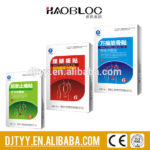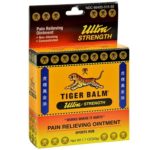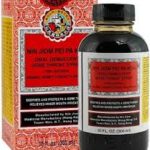8 Methods (ba fa, 八法)
- Sweating (han fa, 汗法)
- Vomitting (tu fa, 吐法)
- Draining Downward (xia fa, 下法)
- Harmonzing (he fa, 和法)
5. Warming (wen fa, 温法)
6. Clearing (qing fa, 清法)
7. Reducing (xiao fa, 消法)
8. Tonifying (bu fa, 补法)
22 Formula Categories (shi Lei, 式 类)
- Tonify and Nourish (bu yang, 补养)
- Disperse the Exterior (fa biao, 发表)
- Induce Vomiting (fa tu 发 吐 )
- Attack the Interior (gong li, 攻里)
- Simultaneous Treatment of the Exterior and Interior (biao li, 表 里)
- Harmonize and Relieve (he jie, 和 解)
- Regulate the Qi (li qi, 理气)
- Regulate the Blood (li xue, 理血)
- Dispel Wind (qu feng, 祛风)
- Dispel Cold (qu han, 祛寒)
- Clear Summer Heat (qing shu, 清暑)
12. Resolve Dampness (li shi, 利湿)
13. Moisten Dryness (run zao, 润 燥)
14. Drain Fire (xie huo, 泻火)
15. Eliminate Phlegm (jie tan, 截痰)
16. Eliminate and Guide out Stagnation (xiao dao, 消导)
17. Stabilize and Bind (shou se, 收 涩)
18. Kill Parasite (sha chong, 杀虫)
19. Improve Vision (ming mu, 明目)
20. Abscess and Sores (yong yang, 痈)
21. Emergencies (jiu ji, 救急)
22. Menstruation and Child Birth (jing chan, 经期 and 孩子出生)
4 Hierarchy of Herbs in a Formula
1. Chief (jun yao, 君药): The must have ingredient and the main active ingredient against an ailment
2. Deputy (chen yao, 臣 药): The ingredient that supports the chief ingredient or is a main ingredient targeting a coexisting disease.
3. Minister (Zuo Yao, 佐药): The ingredient that 1) reinforces the effect of the chief or deputy ingredient, or treats a less crucial part of the disease. 2) moderates the toxicity of the chief or deputy by having an opposing effect of the chief ingredient.
4. Guide (Shi Yao, 使药): 1) Focuses the action of the formula on a specific channel or body part. 2) Harmonizes and integrates the actions of ingredients.
3 Types of Modifications to Formulas
| Mods | Chief | Deputy | Other | Action |
| 1 | unchanged | unchanged | + or - | unchanged |
| 2 | unchanged | changed | changed | changed |
| 3 | changed | changed | changed | changed |
- Only the minor ingredients are added or subtracted. All other parts of the formula are unchanged.
- Chief ingredient is constant but all or most of other ingredients are changed and the action of the formula is changed.
- Changing one or more ingredients in the formula changes everything about it, including hierarchy structure and actions.
Forms and Preparations
Decoctions (tang ji, 汤剂): All ingredients are boiled with water, wine or both. The broth is strained into a cup and drank by the patient. Advantages are the quick absorption and immediate relief. It's easy to adapt the formula to patient needs. Disadvantages are the bitter taste, the time-consuming preparation, the expense, and hard to prepare as exactly prescribed. The effectiveness of Decoctions depends on proper water, equipment (stoneware, ceramic, or stainless steel), amount of water (half inch above herbs or 250ml to 30g herbs), heat (high or low), and time/frequency (decoct twice or cook longer).
Powder (san ji, 散剂): Ingredients are ground into powder. The powder form can be blown into the nose or throat, or put into a tea bag and steeped as tea. Advantages are the lower cost, the ability for longer storage, quicker preparation and can easily adjust dosage size by varying the amount of powder.
Pills (wan zi, 丸子): Pills are absorbed slowly and over a long period of time. It's easier to sore and less expensive. This form is usally used for chronic disorders. It's also used for ingredients that should not be boiled. Most pills are made with water, honey, or other coagulants.
Soft Extracts (gao ji):
- Gao Yao - Ingredients are cooked with water or vegetable oil until dissolved and congealed. When mixture is combined with with beeswax, it forms a plaster.
- Yao Gao - When powder ingredients are added to the heated mixture of oil and beeswax, you get an ointment
- Jian Gao - Repeat the decoction until it's very concentrated. Add honey or sugar to the concentration to make a syrup.
Examples below:
Wine(yao jiu, 酒): Soaking ingredients in rice wine or other alcoholic liquids.
Lozenges (ding ji): Powdered ingredients mixed with a pliable material like sugar, gelatin or acacia gum and cut into round, diamond or rhombus shapes. (ie cough drops)
Tablets (pian, 片) Active ingredients of the formula are processed with filler into a tablet and coated with a material for easy ingestion or targeted release for a particular organ.
Granules (li, 粒): Decocting the ingredients until very concentrated and them ground up the dregs to use as a thickener. The mixture is then dried. Granules have quicker absorption rate than pills and tablets and is often more potent.
Injections (zhen, 针): The active ingredients of a formula are extrated and delivered by needle. It goes directly into the blood stream, bypassing the digestive system.
Capsules: herbs are placed inside a two part gelatin shell. May contain flavoring, preservated and dyes. This is used for herbs that may interact with digestive juices.
Teas (cha, 茶) : Mixtures of herbs around into fine pieces and steeped in boiling water. Tend to be slow acting.
Juice (zhi, 汁): Herbs are pressed with water and pasteurized.
References
- Balch P, Bell S. "Prescription for Herbal Healing". Bottom Line Books, 2nd edition (2014). ISBN 0-88723-709-6
- Bensky D, Barolet R "Chinese Herbal Medicine: Formulas & Strategies". Eastland Press, 1 edition (1990). ISBN-10:0-939616-10-6.
- Chinese_Medical_Terms



